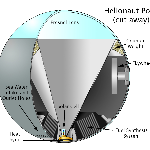
Robotic Solar Armada by Helionauts
Please find below the
Finalist Evaluation
Judges'' ratings
| • | Novelty: | |
| • | Feasibility: | |
| • | Impact: | |
| • | Presentation: |
Judges'' comments
SUBJECT: Your proposal has been selected as a Finalist!
Congratulations! Your proposal, Robotic Solar Armada, in the Energy Supply contest, has been selected to advance to the Finalists round.
Be proud of your accomplishment – more than 350 proposals were submitted and only a very small number have been advanced through these two rounds of judging.
As a Finalist, your proposal is eligible for the Popular Choice award, which is determined by public voting.
If you haven’t already, you will soon receive an email from the Climate CoLab staff with details about the voting period. If you don’t receive that email within the next day, or have other questions, please contact the Climate CoLab staff at admin@climatecolab.org
All winners will be announced the week after the voting period ends, on September 12, 2015 at midnight Eastern Time.
If your proposal is selected as a Popular Choice you will receive a special invitation to attend selected sessions at MIT’s SOLVE conference and present your proposal before key constituents in a workshop the next day, where a $10,000 Grand Prize will be awarded. A few select Climate CoLab winners will join distinguished SOLVE attendees in a highly collaborative problem-solving session. Some contests have additional prizes given by the contest sponsor.
Thank you for your work on this very important issue. We’re proud of your proposal, and we hope that you are too. Again, congratulations!
2015 Climate CoLab Judges
Additional comments from the Judges:
Comment 1:
Very interesting idea, that need substantial additional study and resources.
From the technical point of view, I see a real challenge of maintaining the tracking precision required for a CPV system in such an environment. There are already significant difficulties in utility scale plants in "ideal project"....
The economics of the systems are yet to be proven and most likely they will be very challenging, considering also the transmission costs.
Regulatory framework may be present some issues as well as, to my knowledge, additional codes should be devised.
Overall, very significant resources, much higher than the one mentioned, will be needed to understand if the solution is viable
Comment 2:
Well structured pitch and description, thoughtful approach to what is required for success beyond the technology, still concerned with the length of time to scale.
Comment 3:
While every step in this proposal is technically feasible, the number of steps and the overall complexity cause me great concern. I worry very much if this is anywhere close to an economically feasible pathway. Some examples:
In the comments, the proposer says a flotilla consists of 2000 pods that each produce a kg per day of say methanol. That is 2 tonnes per day. The price of methanol quoted in the proposal for China is $300/ton. That means a flotilla only produces $600/day of product – nowhere near what it takes to cover capital and operating costs.
The proposer says one motivation is that CO2 has higher concentration in seawater than in atmosphere. However, the CO2 in atmosphere is in equilibrium with the CO2 in seawater. Therefore, they have the same free energy. This indicates to me that capturing CO2 from seawater will be as difficult as from the atmosphere. The proposed method of extracting CO2 from seawater is drawing a vacuum (which would need to be less than .0004 atm). This would be very expensive and is only one step of many.
Another reason stated is availability of sunlight. However, surface area at sea for collecting solar energy is more expensive than land. Choosing a desert site would be much cheaper and probably just as good in terms of solar availability. I would think a land based system a much better place to start.
In summary, while an interesting concept, much more work is needed to show that the proposed concept can be economically viable.
Comment 4:
There is an interesting technology presented here, though the scale of deployment required to have an impact and the amount of R&D and infrastructure required to pull it off is high. I would be interested in hearing more about this technology after a year or so of engineering and prototyping has been completed.
Semi-Finalist Evaluation
Judges'' ratings
| • | Novelty: | |
| • | Feasibility: | |
| • | Impact: | |
| • | Presentation: |
Judges'' comments
Overall, a very interesting idea/design and worth of further study. i would like to understand more what already exists in the market in this space, also a better sense of the feasibility.
I think that the concept is interesting and worthy of further study. Putting aside skepticism and looking at this purely from a technology development angle, you will need to more clearly understand the performance and economics of your system as well as the elements that are "off-the-shelf" and just need added to the system versus those that require new technology development. The more of the latter you have, the riskier your concept will become and the more difficult it will be to sell the idea to potential funders.
I would suggest working to limit the new technology and focus on the new combination and application of existing technology where possible. I would also suggest conducting a study to better estimate the amount of ocean CO2 scrubbing might be accomplished with each unit so that you can estimate the number of units required to make a substantial impact - this will speak to the viability of the concept depending on the answer. Further, the underlying economics need to be well understood before funders would be very worried about some of the logistical hurdles to getting the technology commercialized.
Speaking of commercialization - 8 years from concept to mass production is an extremely aggressive timeline. Most technologies will take decades to develop and commercialize and you should seek to understand the reasons why that is the case so that you can better articulate your plan for how you will achieve success. Failing that, the aggressive plan could come off as overly optimistic.
Some additional points for consideration:
- Better describe fuel synthesis process and market in up front section of proposal (how, what type of fuel, how it is transported, and possible market)
- Required team: be more specific on the types of engineering expertise and other expertise required (would also need a software/communications expert, shipping/ocean law permitting lawyer, marine engineer, etc.)
- Transportation of platforms: can you leverage existing shipping activities?
- Need to provide more information on scale (what size are the collectors, how much fuel could be sold at a given scale)
- What would the O&M look like?
- How far how to sea would the platforms be? What channels could be used? There is a lot of shipping activity and permitting limitations that need to be required.
- Have you considered SIDS implementation? As they are heavy importers of fossil fuels, could be good initial markets as the price point would be higher.
 Abe Dillon Jul 15, 2015 12:27 | Proposal creator
I went in to much greater detail about how the synfuel system works, the components involved, and the markets for two different forms of synfuel: syngas, and methanol.
I removed discussion about new technology other than the design of the pod hull. I explain why it's not feasible to use an off-the-shelf hull.
I describe the costs and CO2 capture capabilities of the system in the Impact section.
I extended my time-to-market estimate to a more feasible 15 years.
I enumerated the required engineering and legal expertise.
I did not cover the possibility of leveraging existing shipping activities to bring the synfuel to market. I ran out of time and space.
I provided some information about scale (2000 pods in a flotilla, the pods are 1-meter in radius and produce a little more than 1 kg of syngas or methanol per day) in the Impact/CO2 sequestration section.
I did not cover O&M very well. I ran out of time and space.
I did not cover how far out to sea the platforms will be. for the pilot period, they don't need to be mobile, so they can be fixed off-shore.
I mention the merits of basing the pilot program in a SIDS in the "Where will these actions take place?" section.
|